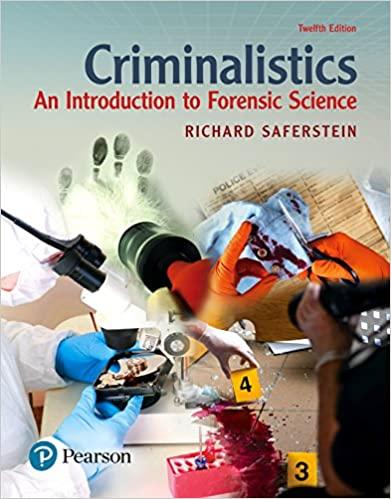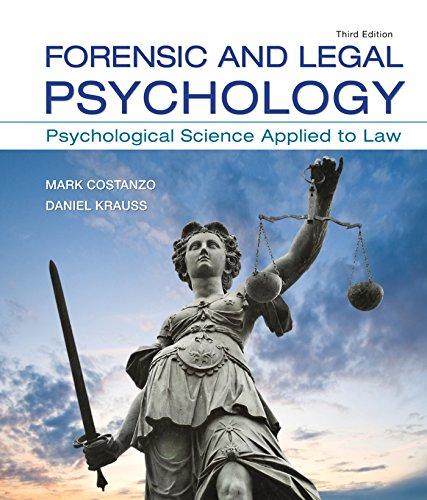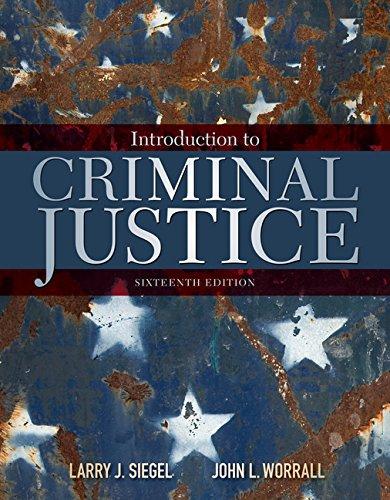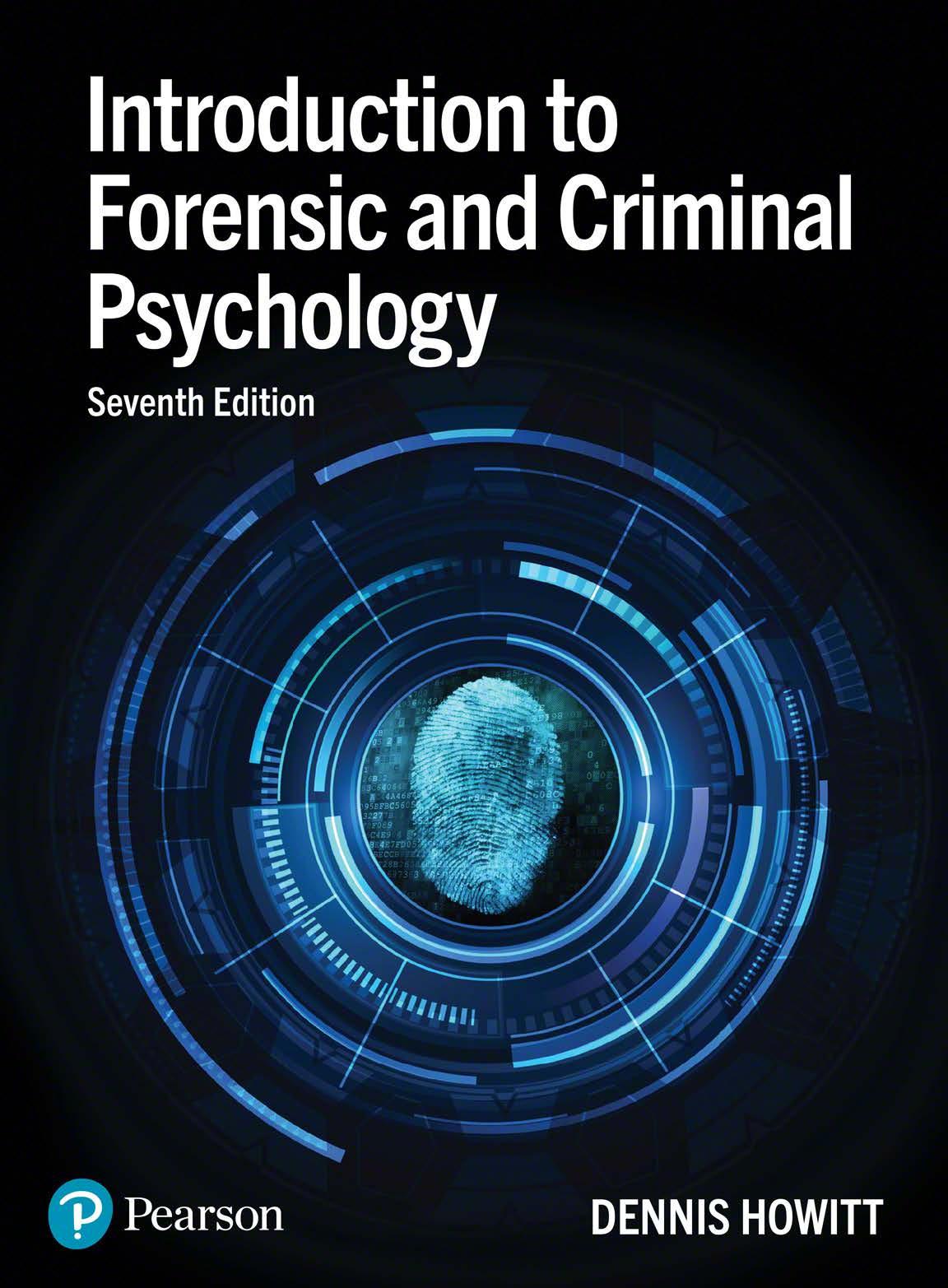Introduction to Forensic and Criminal Psychology 7th Edition Dennis Howitt
Visit to download the full and correct content document: https://ebookmass.com/product/introduction-to-forensic-and-criminal-psychology-7thedition-dennis-howitt/
More products digital (pdf, epub, mobi) instant download maybe you interests ...
Introduction to Research Methods in Psychology, 4th ed 4th Edition Dennis Howitt
https://ebookmass.com/product/introduction-to-research-methodsin-psychology-4th-ed-4th-edition-dennis-howitt/
Introduction to Forensic Psychology: Research and Application (NULL)
https://ebookmass.com/product/introduction-to-forensicpsychology-research-and-application-null/
Forensic Science: An Introduction to Scientific and Investigative
https://ebookmass.com/product/forensic-science-an-introductionto-scientific-and-investigative/
Criminalistics: An Introduction to Forensic Science (12th Edition)
https://ebookmass.com/product/criminalistics-an-introduction-toforensic-science-12th-edition/
Forensic Psychology 5th Edition Joanna Pozzulo
https://ebookmass.com/product/forensic-psychology-5th-editionjoanna-pozzulo/
Forensic and Legal Psychology 3rd Edition, (Ebook PDF)
https://ebookmass.com/product/forensic-and-legal-psychology-3rdedition-ebook-pdf/
Criminal Defense-Based Forensic Social Work 1st Edition
https://ebookmass.com/product/criminal-defense-based-forensicsocial-work-1st-edition/
Introduction to Criminal Justice 16th Edition, (Ebook PDF)
https://ebookmass.com/product/introduction-to-criminaljustice-16th-edition-ebook-pdf/
Introduction to Criminal Justice 15th Edition, (Ebook PDF)
https://ebookmass.com/product/introduction-to-criminaljustice-15th-edition-ebook-pdf/
Introduction to Forensic and Criminal Psychology
At Pearson, we have a simple mission: to help people make more of their lives through learning.
We combine innovative learning technology with trusted content and educational expertise to provide engaging and effective learning experiences that serve people wherever and whenever they are learning.
From classroom to boardroom, our curriculum materials, digital learning tools and testing programmes help to educate millions of people worldwide – more than any other private enterprise.
Every day our work helps learning flourish, and wherever learning flourishes, so do people.
To learn more, please visit us at www.pearson.com/uk
Introduction to Forensic and Criminal Psychology
7th Edition
Dennis Howitt Loughborough University
Harlow, England
Pearson Education Limited
KAO Two
KAO Park
Harlow CM17 9NA
United Kingdom
Tel: +44 (0)1279 623623
Web: www.pearson.com/uk
First published 2002 (print)
Second edition published 2006 (print)
Third edition published 2009 (print)
Fourth edition published 2011 (print)
Fifth edition published 2015 (print and electronic)
Sixth edition published 2018 (print and electronic)
Seventh edition published 2022 (print and electronic)
© Pearson Education Limited 2002, 2006, 2009, 2011 (print)
© Pearson Education Limited 2015, 2018, 2022 (print and electronic)
The right of Dennis Howitt to be identified as author of this work has been asserted by him in accordance with the Copyright, Designs and Patents Act 1988.
The print publication is protected by copyright. Prior to any prohibited reproduction, storage in a retrieval system, distribution or transmission in any form or by any means, electronic, mechanical, recording or otherwise, permission should be obtained from the publisher or, where applicable, a licence permitting restricted copying in the United Kingdom should be obtained from the Copyright Licensing Agency Ltd, Barnard’s Inn, 86 Fetter Lane, London EC4A 1EN.
The ePublication is protected by copyright and must not be copied, reproduced, transferred, distributed, leased, licensed or publicly performed or used in any way except as specifically permitted in writing by the publishers, as allowed under the terms and conditions under which it was purchased, or as strictly permitted by applicable copyright law. Any unauthorised distribution or use of this text may be a direct infringement of the author’s and the publisher’s rights and those responsible may be liable in law accordingly.
All trademarks used herein are the property of their respective owners. The use of any trademark in this text does not vest in the author or publisher any trademark ownership rights in such trademarks, nor does the use of such trademarks imply any affiliation with or endorsement of this book by such owners.
Pearson Education is not responsible for the content of third-party internet sites.
ISBN: 978-1-292-29578-7 (print) 978-1-292-29579-4 (PDF) 978-1-292-29580-0 (ePub)
British Library Cataloguing-in-Publication Data
A catalogue record for the print edition is available from the British Library
Library of Congress Cataloging-in-Publication Data
Names: Howitt, Dennis, author.
Title: Introduction to forensic and criminal psychology / Dennis Howitt, Loughborough University.
Description: 7th edition. | New York : Pearson Education Limited, 2022. | Includes bibliographical references and index.
Identifiers: LCCN 2021062747 | ISBN 9781292295787 (hardback)
Subjects: LCSH: Criminal psychology. | Forensic psychology.
Classification: LCC HV6080 .H69 2022 | DDC 364.3--dc23
LC record available at https://lccn.loc.gov/2021062747
10 9 8 7 6 5 4 3 2 1
26 25 24 23 22
Image on cover and chapter titles: maxkabakov/iStock/Getty Images Plus/Getty Images
Panuwat Sikham/iStock/Getty Images Plus/Getty Images
Print edition typeset in 9.5/12 pt Times LT Pro by Straive
Printed in Slovakia by Neografia
NOTE THAT ANY PAGE CROSS REFERENCES REFER TO THE PRINT EDITION
To the continued memory of Professor Marie Jahoda who died in 2001. I have a big personal debt. Not only did she let me study on the psychology degree course she had set up at Brunel University, but also she showed me that some things in life are worth getting angry about.
List of figures, tables and boxes
6.4
6.5
6.6 How anger partially mediates between being a victim of
6.7
7.1
and non-violent delinquency (based on the work of Sigfusdottir, Gudjonsson and Sigurdsson (2010))
7.2 DSM criteria for a diagnosis of kleptomania (American Psychiatric Association, 2013)
7.3 Some of the main theories concerning the drugs–crime relationship according to Bennett, Holloway and Farrington (2008)
7.4 The Matching Heuristic Model applied to a burglar’s decision-making process
7.5 Background factors in male arsonists
7.6 The different trajectories leading to firesetting
7.7 Gannon et al.’s model of firesetting
8.1
8.2
8.3
8.4 Contrasting conceptualisations
8.5 Leyton’s epochs of murder
8.6 Multi-factorial model of serial killing
8.7 The relationship between cycles of abuse and economic stress
8.8 Psychopathic stalkers are uncommon but they show some of the characteristics above
8.9 The main factors leading to desistance
9.1
9.2
9.3
9.4 Crossover behaviours in offenders showing the percentage of crossovers of various types in the total sample of offenders
9.5 Some aspects of criminal careers
9.6 Internalisation, externalisation and sexualisation as concepts in the explanation of sex offending
11.1 The basic procedural steps for the revised cognitive interview according to Wells, Memon and Penrod (2007) and Fisher and Geiselman (1992)
12.4
12.5
13.3 How to plan a satisfactory line-up according to the suggestions of Brewer and Palmer (2010)
13.4 The no-cost view of eyewitness procedure reform
13.5 The trade-off view of eyewitness reform
14.1 Major stages of FBI crime scene profiling
14.2 Features of FBI-style clinical profiling and statistical profiling
14.3 Comparing profilers with others in terms of accuracy
14.4 The homology hypothesis that there is a convergence between characteristics of the crime scene and the characteristics of the offender
15.1 The basics of geographical offender profiling
15.2 The statistical approach to profiling
15.3 Schematic representation of crime scene characteristics
15.4 Some of the different types of consistency between the crime scene characteristics and the offender
15.5 Consistency of crime scene themes over serial killings
15.6 The different typologies of rape evaluated in Goodwill et al.’s (2009) study
15.7 Behaviour involves personality characteristics plus situational characteristics
15.8 Illustrating the negative relationship between victim and sex offender age
15.9 Age of victim and offender relationships taking into account the moderating effects of planning and gratuitous violence
16.1 Possible mechanisms of repressed memories
16.2 Two types of recovered memory claims (Geraerts et al.) 2008
17.1 Kassin’s argument concerning the power of confession evidence
17.2 The major types of reasons given for confessing based on Gudjonsson and Sigurdsson’s (1999) analysis
17.3 The Reid steps during the interrogation process
17.4 Some of the differences between false confessors and other youngsters according to
17.5 Interrogation tactics and the percentage believing that they would lead to false confessions
18.1 Showing the tendency to invent a ‘false’ postcode but which reveals the place lived in
18.2 Illustrating how false postcodes do not correspond to real ones
18.3 Signal detection theory applied to lie detection
18.4 The lie detection process according to the RAM model
18.5
19.4 The accuracy of the CQT polygraph technique based on past studies
The components of a statement validity analysis
19.6 The structure of a statement validity analysis
19.7 Criterion-based content analysis: some aspects of truthful narratives
20.1 Open-ended versus focused/closed questions as they might appear in a
20.4 The design of London, Bruck and Melnyk’s (2009) study of the long-term effects of suggestive interviewing
20.5 The proposed underlying dimensions of professional attitudes to child protection decisions
21.1 How the concept of mental disorder includes mental illness and mental incapacities
21.2 The five axes of the Diagnostic and Statistical Manual
21.3 The World Health Organization’s system for classifying mental and related disorders
21.4
23.1
23.2
23.3 The four conditions of Jones and Harrison’s (2009) study
23.4 What cards need to be turned over to test the rule that if there was a vowel on one side there is an even number on the other?
23.5 The basic signal detection problem applied to
23.6 The dangerous decisions theory of how assessments of credibility are used in the courtroom
24.6
25.1
25.2
27.4 Some of the good predictors of sexual recidivism and some of the poorer ones
27.5 The unlikely steps in a juvenile sex offender’s thinking which would lead to a deterrent effect of sex offender registration and notification laws
27.6
2.1
Pearson’s Commitment to Diversity, Equity and Inclusion
Pearson is dedicated to creating bias-free content that reflects the diversity, depth and breadth of all learners’ lived experiences. We embrace the many dimensions of diversity including, but not limited to, race, ethnicity, gender, sex, sexual orientation, socioeconomic status, ability, age and religious or political beliefs.
Education is a powerful force for equity and change in our world. It has the potential to deliver opportunities that improve lives and enable economic mobility. As we work with authors to create content for every product and service, we acknowledge our responsibility to demonstrate inclusivity and incorporate diverse scholarship so that everyone can achieve their potential through learning. As the world’s leading learning company, we have a duty to help drive change and live up to our purpose to help more people create a better life for themselves and to create a better world.
Our ambition is to purposefully contribute to a world where:
• Everyone has an equitable and lifelong opportunity to succeed through learning.
• Our educational products and services are inclusive and represent the rich diversity of learners.
• Our educational content accurately reflects the histories and lived experiences of the learners we serve.
• Our educational content prompts deeper discussions with students and motivates them to expand their own learning and worldview.
We are also committed to providing products that are fully accessible to all learners. As per Pearson’s guidelines for accessible educational Web media, we test and retest the capabilities of our products against the highest standards for every release, following the WCAG guidelines in developing new products for copyright year 2022 and beyond. You can learn more about Pearson’s commitment to accessibility at: https://www.pearson.com/us/accessibility.html
While we work hard to present unbiased, fully accessible content, we want to hear from you about any concerns or needs regarding this Pearson product so that we can investigate and address them.
• Please contact us with concerns about any potential bias at: https://www.pearson.com/report-bias.html
• For accessibility-related issues, such as using assistive technology with Pearson products, alternative text requests, or accessibility documentation, email the Pearson Disability Support team at: disability.support@pearson.com
Preface
The writing of this seventh edition of Introduction to Forensic and Criminal Psychology was interrupted by the COVID-19 pandemic, so the updating covers a four-year period. It is important to me that this book reflects the most significant up-to-date research and ideas in the field. Our understanding of issues gradually evolves with every new theory and research study. Forensic and criminal psychology is not simply a compendium of settled facts. The disparity of voices on a topic is essential and needs to be demonstrated in any textbook. Consequently I have endeavoured to represent this variety of views as well as changes in the dominant views within the field. This is not entirely an orderly, even and predictable process. What appeared to be the case in the first edition of the text may no longer apply or may have substantially reversed. These developments exemplify not a series of errors but the way in which disciplines advance. We can see this both in the short term and the long term. It should also be possible to spot the unevenness of this progress. In its simplest form, over the various editions once-hot topics have gradually received less attention and Cinderella topics have blossomed markedly. At its most mundane, this means that some chapters have been updated with lots of new material, while a very few have changed little. No doubt there will be a reversal of the fortunes of some of these in future years. Nevertheless, some traditional topics have been retained simply because they were important in the early days of the discipline. This is particularly the case with FBI-style offender profiling. Nevertheless, there is a great deal to be learnt from topics like this so that mistakes and inadequacies are not repeated.
I am pernickety about contextualising research. Because legal and criminal justice systems are not the same in different parts of the world, we should acknowledge this fact. It is important to understand just what this variation is. This cannot be done by simply ignoring context – as has so frequently been done in the parent discipline, psychology. On
the contrary, I would argue that the context of the research is integral to a full appreciation of any research. So throughout the book it should generally be clear just where in the world the research was carried out. This should be informative but is never an excuse for neglecting the research. That the research was done, say, in Poland or Australia does not mean that it has no relevance to the United Kingdom. But its relevance will always need to be considered. Forensic and criminal psychology is international in its nature and textbooks ought to reflect this.
The question of the amount of detail to include is a complex matter. I firmly believe that sufficient detail should be provided to enable the reader to do something with the material apart from merely citing it. The stimulus to thought lies in the detail provided. There are many textbooks which are structured around a commentary or linking text bolstered by numerous citations of the literature, with no clear relationship between the two. Some academic writing, if not a great deal, is like that. This imposes severe limits on what the student can learn and also constrains the critical thinking which academics cherish. It is impossible to form an opinion or give a critique on something one has only read a sentence about. My preference is to give the reader something to think about and possibly question. Just how does a particular research study lead to a particular conclusion and is this the only possible conclusion? How did this research develop from previous research? How does this research lead to future research? The questions which the reader should be asking are much more obvious when a text provides material to get one’s teeth into. Of course, the text asks critical questions where these need to be addressed – especially because they are part of a debate among professionals in the field. When deciding whether to include a new piece of research, the fundamental criterion is whether it introduces a significant new idea or question. In what way does the research change the way that we look at things? In
what way does the new work place established wisdom on the back foot?
That I rely heavily on the judgement of others when making my decisions is not only self-evident but also unavoidable. What the social network of forensic and criminal psychologists collectively judge to be important is one way of defining what the discipline is, after all. I also consciously prioritise theory in the text for much the same reason. Theory which synthesises what has gone before helps the text tell a coherent story. Often the theories, in themselves, are not fully testable in the empiricist tradition, but they do have something to say and they have to say it about a substantial chunk of research. Similarly, modern ways of synthesising research findings such as the systematic review and meta-analysis are integral to the presentation of research findings in the text. One reason is the impossibility of incorporating the vast number of research studies into the text without the compact summaries which meta-analysis, for example, provides. Of course, there are problems with systematic reviews and meta-analyses but they point in directions which might otherwise have been obscured by the sheer amount of the evidence. Anyway, they are part and parcel of modern research and need to be included if only for that reason alone. Researchers refer to them and use them a lot. Better get used to them.
All of this is very different from the situation when I was a student. My first real contact with the criminal justice
system was the six months I spent at Wakefield Prison, in Yorkshire. My strongest recollection of this period was the emerging realisation that, for the most part, the men there seemed like ordinary men despite the fact that they were incestuous fathers or killers or had committed some other unfathomable crime. Nobody at university, staff or student, shared my interest in the field of crime and I had no idea of how my fumbling research interest could be turned into good psychology. Sex offenders fascinated me and I tried to research incestuous fathers but this was not a serious topic for research in the prevailing ethos of those days. A few years on and the sexual abuse of children became a massive area for research in several disciplines. Perhaps I could have been responsible for that, but I was not. The boat was missed. Others, a little later, had much better ideas of what were the important things to think about, research and practise. But the field of forensic and criminal psychology has, nevertheless, been a stimulus to my own work and its massive development over the years a delight to watch. Psychology students today who study forensic and criminal psychology are exposed to the power of research and theory in creating understanding of one of the fundamental institutions of the state – the criminal justice system.
Dennis Howitt
Author’s acknowledgements
A curious thing about books is that only the authors’ names are to be found on the cover. However, there would be no book to hold in your hands if it were left to the authors alone. Authors are dependent on numerous enormously talented people who make them appear far more able than they actually are. Take proof reading as a simple example. If I am faced with this task for a manuscript I will miss the vast proportion of the typos and, worse still, change the text willy-nilly. That will never do. Fortunately help is at hand in the form of people with the proof reading skills for which I was back of the queue. They also got ahead of me in the clever queue. And to top it all they are so nice and polite even when exasperation with the author must be beyond tolerance.
Much the same is true of all of the other individuals that I wish to thank but in their own distinct ways. They
are all a joy to work with. Thanks to the internet they are widely spaced around the world. It is very welcome to work with colleagues in India. Several editions of this book were written in Southern India though not this particular one regrettably.
The following is a list of those who I wish to thank but it is also a list of awesome folk:
Catherine Yates (Portfolio Manager)
Michael Heritage (Cover Designer)
Divya Sharma (Content Producer)
Ajanta Bhattacharjee (Managing Content Producer)
Straive, Chithra Rajasekaran (Project Manager)
Antonia Maxwell (Copyeditor)
Jonathon Price (Proofreader)
Thank you is not enough – gratitude is closer.
What is forensic and criminal psychology?
Overview
• The strictest definition regards forensic psychology as psychology applied to the work of courts of law. Nevertheless, often the term is used more generally to include all aspects of criminal justice.
• The term ‘forensic and criminal psychology’ is used in this book to describe the very wide discipline of psychology applied to the law, legal system, victims and law breakers.
• The disciplines of psychology and the law both concern human nature but they have many incompatibilities. When lawyers and psychologists use identical words, different meanings may be intended.
• The twin skills of ‘practitioner’ and ‘researcher’ are involved in the development of forensic and criminal psychology. Practitioners are routinely expected to pursue research.
• Histories of forensic and criminal psychology depend on the finishing point rather than the starting point. Clinical psychologists, for example, may see the history primarily in terms of how concepts of mental illness and other vulnerabilities developed within the legal system and the need for expert advice to inform courts of law. On the other hand, academic psychologists may see the history as lying in the work of European and US academics around the start of the twentieth century.
• The growth of forensic and criminal psychology became rapid in the late twentieth century and up to now. Prior to this interest in the field was somewhat spasmodic, perhaps minimal. Nevertheless, the discipline had much earlier roots in crucial legal changes which demanded psychological expertise.
• Forensic and criminal psychology benefits from being a truly international discipline. It unites psychologists from a variety of fields of psychology, though it can now be regarded as a specialism in its own right.













